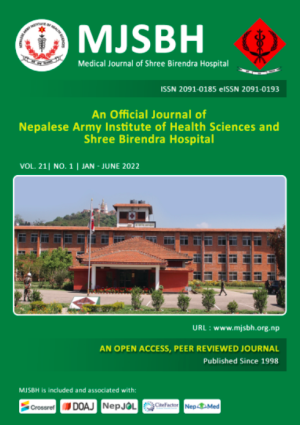Residual Lung Parenchymal CT Changes in COVID-19 Patients and its Association with Common Predictors
Keywords:
Chest CT, COVID-19, Predictors, Severity scoreAbstract
Introduction: Chest computed tomography (CT) is used for the screening and diagnosis of COVID-19 pneumonia. The aim of the study is to study the prevalence of residual lung parenchymal CT changes in COVID-19 patients and its association with common predictors.
Methods: Longitudinal study conducted at Shree Birendra Hospital in which diagnosed COVID-19 patients with initial CT scan showing COVID-19 related changes were retrospectively enrolled after ethics approval. The study period was from 15 February 2020 to 15 November 2021. Chest CT changes were evaluated and CT scan severity score (CT SS) assigned. Data was entered in Microsoft Excel and analysed in SPSS (Statistical Package for Social Sciences) version 16.
Results: Males were more common (72.6%) among the 62 enrolled participants with the mean age 53.63 ± 15.05 years. Median interval between two scans was 137 days. Residual lung parenchymal CT changes were seen in 43 (69.4%) participants. Hypertension (25, 40.3%) and GGO (55, 88.7%) were the most common comorbidity and CT features respectively. The mean initial and final CT SS was 10.84 ± 5.87 and 3.55 ± 4.58 respectively (Total score 25, p = 0.001). Age was significantly associated with severity of CT score (p = 0.04).
Conclusions: A large percentage of COVID-19 patients have chest CT changes after three months of initial chest CT scan. CT SS reduced significantly in the second scan. Similar studies with long term serial CT follow up of patients is recommended to be carried out in future.
Downloads
Downloads
Published
How to Cite
Issue
Section
License
Copyright (c) 2022 Medical Journal of Shree Birendra Hospital

This work is licensed under a Creative Commons Attribution-NonCommercial-NoDerivatives 4.0 International License.
This license enables reusers to distribute, remix, adapt, and build upon the material in any medium or format for noncommercial purposes only, and only so long as attribution is given to the creator.




